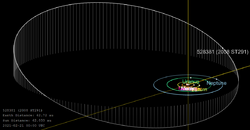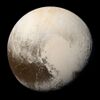Astronomy:(528381) 2008 ST291
 Orbit of (528381) 2008 ST291 | |
| Discovery[1][2] | |
|---|---|
| Discovered by | M. E. Schwamb M. E. Brown D. L. Rabinowitz |
| Discovery site | Palomar Obs. |
| Discovery date | 24 September 2008 |
| Designations | |
| (528381) 2008 ST291 | |
| 2008 ST291 | |
| Minor planet category | TNO · SDO res 1:6[3] |
| Orbital characteristics[4] | |
| Epoch 27 April 2019 (JD 2458600.5) | |
| Uncertainty parameter 3 | |
| Observation arc | 9.27 yr (3,385 d) |
| |{{{apsis}}}|helion}} | 157.437 AU (23.5522 Tm) |
| |{{{apsis}}}|helion}} | 42.3114440 AU (6.32970193 Tm) |
| 99.8742972 AU (14.94098220 Tm) | |
| Eccentricity | 0.5763530 |
| Orbital period | 998.30 yr (364,629 d) |
| Mean anomaly | 23.349° |
| Mean motion | 0° 0m 3.6s / day |
| Inclination | 20.758° |
| Longitude of ascending node | 330.97° |
| 324.65° | |
| Physical characteristics | |
| Mean diameter | 549 km (est.)[5] 584 km (est.)[3] 612 km[6][7][lower-alpha 1] 345–773 km[7][lower-alpha 2] |
| Geometric albedo | 0.09 (assumed)[3][5] |
| Apparent magnitude | 22.24[6] |
| Absolute magnitude (H) | 4.4[1][4] 4.3[6] 4.6[5] |
(528381) 2008 ST291, provisional designation 2008 ST291, is a 1:6 resonant trans-Neptunian object located in the outermost region of the Solar System that takes almost a thousand years to complete an orbit around the Sun.[5] It was discovered on 24 September 2008 by American astronomers Megan Schwamb, Michael Brown and David Rabinowitz at the Palomar Observatory in California, with no known earlier precovery images.[1]
Numbering and naming
This minor planet was numbered by the Minor Planet Center on 18 May 2019 (M.P.C. 114657).[8] As of 2019, it has not been named.[1]
Orbit and classification
2008 ST291 is located at the 1:6 Neptune resonance of 99 AU meaning that it completes roughly 1 orbit for every 6 orbits Neptune makes.[3] It orbits the Sun at a distance of 42.3–157.5 AU once every 998 years and 4 months (semi-major axis of 99.89 AU). Its orbit has an eccentricity of 0.58 and an inclination of 21° with respect to the ecliptic.[4] Currently located at 60.9 AU from the Sun,[6] the object came to perihelion in 1954.[4]
Physical characteristics
Based on an absolute magnitude of 4.4,[1] 2008 ST291 is estimated by the Johnston's Archive to be about 584 kilometres (363 mi) in diameter, assuming a typical albedo of 0.09 for trans-Neptunian objects.[3] Astronomer Mike Brown estimates a slightly smaller 549 km from the same albedo and a fainter 4.6 magnitude.[5] The Asteroid Dynamic Site records a brighter 4.3 magnitude, which calculates to 612 km using the same albedo (and same formula as Johnston's); using the average of these magnitudes and a standard assumed minor planet albedo range of 0.25 ~ 0.05, possible sizes of 345 to 773 km are produced.
See also
- List of Solar System objects most distant from the Sun
- List of trans-Neptunian objects
Notes
References
- ↑ 1.0 1.1 1.2 1.3 1.4 "(528381) 2008 ST291". Minor Planet Center. https://www.minorplanetcenter.net/db_search/show_object?object_id=2008+ST291. Retrieved 29 May 2019.
- ↑ "MPEC 2009-V68 : 2008 ST291". Minor Planet Center. 14 November 2009. https://minorplanetcenter.net//mpec/K09/K09V68.html. Retrieved 29 May 2019.
- ↑ 3.0 3.1 3.2 3.3 3.4 Johnston, Wm. Robert (25 May 2019). "List of Known Trans-Neptunian Objects". Johnston's Archive. http://www.johnstonsarchive.net/astro/tnoslist.html. Retrieved 29 May 2019.
- ↑ 4.0 4.1 4.2 4.3 "JPL Small-Body Database Browser: (2008 ST291)". Jet Propulsion Laboratory. https://ssd.jpl.nasa.gov/sbdb.cgi?sstr=3476640. Retrieved 29 May 2019.
- ↑ 5.0 5.1 5.2 5.3 5.4 Brown, Michael E.. "How many dwarf planets are there in the outer solar system?". California Institute of Technology. http://web.gps.caltech.edu/~mbrown/dps.html. Retrieved 29 May 2019.
- ↑ 6.0 6.1 6.2 6.3 "2008 ST291 – Ephemerides". AstDyS-2, Asteroids – Dynamic Site. https://newton.spacedys.com/astdys/index.php?pc=1.1.3.0&n=2008ST291. Retrieved 19 August 2019.
- ↑ 7.0 7.1 "Conversion of Absolute Magnitude to Diameter for Minor Planets". Archived from the original on 23 July 2011. https://web.archive.org/web/20110723191750/http://www.physics.sfasu.edu/astro/asteroids/sizemagnitude.html. Retrieved 15 August 2019.
- ↑ "MPC/MPO/MPS Archive". Minor Planet Center. https://www.minorplanetcenter.net/iau/ECS/MPCArchive/MPCArchive_TBL.html. Retrieved 29 May 2019.
External links
- Orbit Fit and Astrometric record for 528381, Marc W. Buie, SwRI
- List Of Centaurs and Scattered-Disk Objects, Minor Planet Center
- (528381) 2008 ST291 at AstDyS-2, Asteroids—Dynamic Site
- (528381) 2008 ST291 at the JPL Small-Body Database
 |




